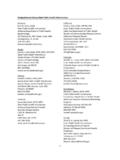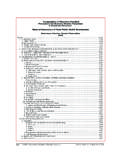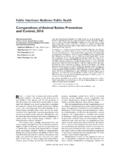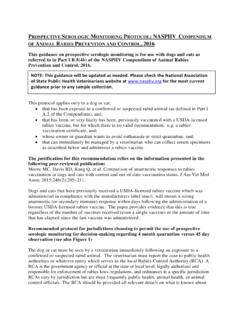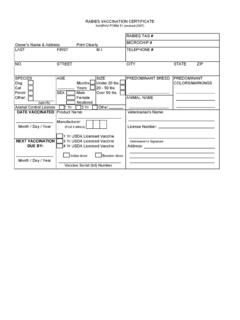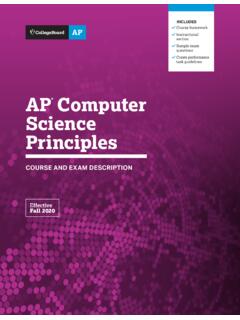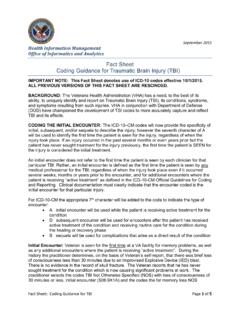Transcription of (Psittacosis) and Pet Birds (Avian Chlamydiosis), 2017 ...
1 BioOne sees sustainable scholarly publishing as an inherently collaborative enterprise connecting authors, nonprofit publishers, academic institutions, researchlibraries, and research funders in the common goal of maximizing access to critical of Measures to Control Chlamydia psittaci Infection Among Humans(Psittacosis) and Pet Birds (Avian Chlamydiosis), 2017 Author(s): Gary Balsamo, DVM, MPH&TMCo-chair Angela M. Maxted, DVM, MS, PhD, Dipl ACVPMJ oanne W. Midla, VMD, MPH, Dipl ACVPM Julia M. Murphy, DVM, MS, Dipl ACVPMCo-chairRon Wohrle, DVM Thomas M. Edling, DVM, MSpVM, MPH (Pet Industry Joint Advisory Council)Pilar H. Fish, DVM (American Association of Zoo Veterinarians) Keven Flammer, DVM, Dipl ABVP (Avian ) (Association of Avian Veterinarians) Denise Hyde, PharmD, RP Preeta K. Kutty, MD, MPHM iwako Kobayashi, MD, MPH Bettina Helm, DVM, MPH Brit Oiulfstad, DVM, MPH (Council ofState and Territorial Epidemiologists) Branson W. Ritchie, DVM, MS, PhD, Dipl ABVP, Dipl ECZM (Avian ) Mary Grace Stobierski, DVM, MPH, Dipl ACVPM (American Veterinary Medical AssociationCouncil on Public Health and Regulatory Veterinary Medicine) Karen Ehnert, and DVM, MPVM, DiplACVPM (American Veterinary Medical Association Council on Public Health and Regulatory VeterinaryMedicine) Thomas N.
2 Tully JrDVM, MS, Dipl ABVP (Avian), Dipl ECZM (Avian) (Association ofAvian Veterinarians)Source: Journal of Avian Medicine and Surgery, 31(3) By: Association of Avian : ( ) is a nonprofit, online aggregation of core research in the biological, ecological, andenvironmental sciences. BioOne provides a sustainable online platform for over 170 journals and books publishedby nonprofit societies, associations, museums, institutions, and use of this PDF, the BioOne Web site, and all posted and associated content indicates your acceptance ofBioOne s Terms of Use, available at of BioOne content is strictly limited to personal, educational, and non-commercial use. Commercial inquiriesor rights and permissions requests should be directed to the individual publisher as copyright of Avian Medicine and Surgery31(3):262 282, 2017 2017 by the Association of Avian VeterinariansSpecial ReportCompendium of Measures to ControlChlamydia psittaciInfection Among Humans (Psittacosis) andPet Birds (Avian Chlamydiosis), 2017 Gary Balsamo, DVM, MPH&TM, Co-chair,aAngela M.
3 Maxted, DVM, MS, PhD, Dipl ACVPM,aJoanne W. Midla, VMD, MPH, Dipl ACVPM,aJulia M. Murphy, DVM, MS, Dipl ACVPM, Co-chair,aRon Wohrle, DVM,aThomas M. Edling, DVM, MSpVM, MPH (Pet Industry Joint Advisory Council),bPilar H. Fish, DVM (American Association of Zoo Veterinarians),bKeven Flammer, DVM, Dipl ABVP (Avian) (Association of Avian Veterinarians),bDenise Hyde, PharmD, RP,bPreeta K. Kutty, MD, MPH,bMiwako Kobayashi, MD, MPH,bBettina Helm, DVM, MPH,bBrit Oiulfstad, DVM, MPH (Council of State and Territorial Epidemiologists),bBranson W. Ritchie, DVM, MS, PhD, Dipl ABVP, Dipl ECZM (Avian),bMary Grace Stobierski, DVM, MPH, Dipl ACVPM (American Veterinary MedicalAssociation Council on Public Health and Regulatory Veterinary Medicine),bKaren Ehnert, DVM, MPVM, Dipl ACVPM (American Veterinary Medical AssociationCouncil on Public Health and Regulatory Veterinary Medicine),band Thomas N. Tully Jr, DVM, MS, Dipl ABVP (Avian), Dipl ECZM (Avian)(Association of Avian Veterinarians)bOn Behalf of the National Association of State Public HealthVeterinariansChlamydia psittaciInfection Among Humans (Psitta-cosis) and Pet Birds (Avian Chlamydiosis) Compendium Committeeand Committee Consultants, the Louisiana Office of Public Health, Infectious DiseaseEpidemiology Section, 1450 Poydras Street, Suite 1641, NewOrleans, LA 70112, USA (Balsamo); New York State Departmentof Health, Bureau of Communicable Disease Control, 651 CorningTower, Albany, NY 12237, USA (Maxted); United States Food andDrug Administration, Office of New Animal Drug Evaluation, 7500 Standish Place, Rockville, MD 20855, USA (Midla); VirginiaDepartment of Health, Office of Epidemiology, 109 GovernorStreet, Madison Building, 4th Floor, Richmond, VA 23218, USA(Murphy).
4 Washington State Department of Health, Zoonotic andVector-borne Diseases Program, 243 Israel Rd, Tumwater, WA98501, USA (Wohrle); Petco Animal Supplies Inc, 10850 ViaFrontera, San Diego, CA 92127, USA (Edling); National Aviary,700 Arch Street, Pittsburgh, PA 15212, USA (Fish); College ofVeterinary Medicine, North Carolina State university , 1040 WilliamMoore Dr, Raleigh, NC 27607, USA (Flammer); The EdenAlternative, 1900 Clinton Ave, PO Box 18369, Rochester, NY14618, USA (Hyde); Division of Healthcare Quality Promotion,Centers for Disease Control and Prevention, 1600 Clifton Rd NE,MS A31, Atlanta, GA 30329, USA (Kutty); Division of BacterialDiseases, Centers for Disease Control and Prevention, 1600 CliftonRd NE, MS C-25, Atlanta, GA 30329, USA (Kobayashi); USDepartment of Agriculture, Animal and Plant Health InspectionService/Veterinary Services, Live Animal Avian Imports, NationalImport Export Services, 4700 River Rd, Riverdale, MD 20737, USA(Helm); County of Los Angeles Public Health, Acute Communica-ble Disease Control Program, 313 N Figueroa St, Rm 212, LosAngeles, CA 90012, USA (Oiulfstad); university of Georgia Collegeof Veterinary Medicine, Infectious Disease Laboratory, 220 Riverbend Rd, Athens, GA 30602, USA (Ritchie); MichiganDepartment of Health and Human Services, 333 South GrandAve, Lansing, MI 48909, USA (Stobierski); Los Angeles CountyDepartment of Public Health, 313 N Figueroa St, Rm 1127, LosAngeles, CA 90012, USA (Ehnert); Louisiana State UniversitySchool of Veterinary Medicine, Department of Veterinary ClinicalSciences, Skip Bertman Dr, Baton Rouge, LA 70803, USA (Tully).
5 Present address (Midla) US Food and Drug Administration Center,Office of New Animal Drug Evaluation, Division of Generic AnimalDrugs, 7500 Standish Place, Rockville, MD 20855, to the :Psittacosis, also known as parrot fever and ornithosis, is a bacterial infection that cancause severe pneumonia and other serious health problems in humans. It is caused byChlamydiapsittaci. Reclassification of the order Chlamydiales in 1999 into 2 genera (ChlamydiaandChlamydophila) was not wholly accepted or adopted. This resulted in a reversion to the single,original genusChlamydia,which now encompasses all 9 species includingChlamydia 2003 2014, 112 human cases of psittacosis were reported to the Centers for DiseaseControl and Prevention through the Nationally Notifiable Diseases Surveillance System. Whilemany types of Birds can be infected byC psittaci, in general, the literature suggests that humancases can most often occur after exposure to infected parrot-type Birds kept as pets, especiallycockatiels, parakeets, and conures.
6 In Birds ,C psittaciinfection is referred to as avianchlamydiosis. Infected Birds shed the bacteria through feces and nasal discharges, and humansbecome infected from exposure to these materials. This compendium provides information aboutpsittacosis and avian chlamydiosis to public health officials, physicians, veterinarians, the pet birdindustry, and others concerned with controlling these diseases and protecting public health. Therecommendations in this compendium provide standardized procedures to controlC psittaciinfections. This document will be reviewed and revised as necessary, and the most current versionreplaces all previous versions. This document was last revised in 2010. Major changes in thisversion include a recommendation for a shorter treatment time for Birds with avian chlamydiosis,additional information about diagnostic testing, including genotyping, clearer language associatedwith personal protective equipment recommended for those caring for confirmed or exposed Birds ,and incorporating a grading scale with recommendations generally based on the United StatesPreventive Services Task Force s words:psittacosis, avian chlamydiosis,Chlamydia psittaci, compendium, avian, pet birdIntroductionChlamydia psittaciis a member of the date, at least 8 serovars and 8corresponding genotypes are well ofC psittacito the genotype levelfrom cultured isolates is important in our under-standing of the epidemiology and clinical impact ofthis bacterium in animals and humans, and itsapplication is encouraged, particularly in 9In some cases, these obligate intracel-lular bacteria can be transmitted from Birds tohumans.
7 The resulting infection is referred to aspsittacosis (also known as parrot fever andornithosis). A range of clinical outcomes has beenreported in association with human cases ofpsittacosis, from the more common subclinical orbrief, self-limiting, influenza-like illness to the lesscommonly reported fulminant psittacosis withmulti-organ ,10 13 With appropriate treat-ment, the infection is rarely most recent time period for which completediagnostic and patient information, like exposure,is available on reported human cases is from 2006to 2012. During this time period, 58 human casesof psittacosis were reported (mean , range 2 21/y) to the Centers for Disease Control andPrevention (CDC).14Of the 58 cases, specificdiagnostic information was available for only 30,and of those, only 2 (7%) were confirmed byculture. For the remaining reports, diagnosis wasbased only on serologic testing, which lacksspecificity and can be difficult to interpret. Theabove count may not be an accurate reflection ofthe actual number of human cases due to limitedtesting and inadequacies of historic diagnostictechniques.
8 Newer diagnostic tests, such as real-time polymerase chain reaction (PCR), are nowavailable, although within specialized in human psittacosis should therefore beinterpreted with caution, taking into accountlimitations in public health surveillance discussedin more detail other types of exposure resulting inillness have been reported, contact with birdsappears to be the primary risk factor ,11,15,16 Persons at greatest risk includethose exposed to Birds via recreational or occupa-tional exposure, such as pet bird owners andbreeders, pet shop employees, zoo employees,poultry workers, veterinarians, diagnostic labora-torians, and wildlife ,12,17 35 Because notall patients recall avian exposure,C psittacishouldbe considered in patients with clinically compatiblesymptoms. For instance, of the 26 cases reportedduring 2006 2012 where exposure was recorded, 19(73%) reported avian exposure. In addition totransmission through direct contact with Birds ,particularly if the Birds were ill or recentlyacquired, human infection can also result fromindirect environmental ,12,21,28,36 48 BALSAMO ET AL.
9 COMPENDIUM OF MEASURES TO CONTROLCHLAMYDIA PSITTACIINFECTION263In this compendium,C psittaciinfection in birdsis referred to as avian chlamydiosis. Chlamydialorganisms have been isolated from more than 460bird species from 30 orders49but are mostcommonly identified in psittacine (parrot-type) Birds , especially cockatiels and budgerigars (alsocalled parakeets or budgies). Among nonpsittacinebirds, infection withC psittacioccurs mostfrequently in pigeons and ,49,50 Amongpoultry species, occupational illness has beenassociated with turkeys in the United States andother countries, as well as chickens and ducks ,8,24,29 Avian chlamydiosis can occur inbirds in the scientific order Passeriformes, such ascanaries and finches, but is less frequently ,12,49,51 53 Purpose and MethodologyThe recommendations in this compendiumprovide standardized procedures for managingavian chlamydiosis in the pet bird population,which is an essential step in efforts to reducepsittacosis among humans.
10 Additionally, thiscompendium offers information and guidanceregarding human illness, including diagnosis andtreatment. This compendium is intended to guidepublic health officials, physicians, veterinarians,the pet bird industry, and others concerned withthe control ofCpsittaciinfection and theprotection of public identify relevant literature, a comprehensivesearch of PubMed was performed by using variouscombinations of search terms including, but notlimited to: psittacosis,Chlamydia psittaci,Chlamy-dophila psittaci,C. psittaci, pneumonia, ornithosis,respiratory, human, diagnosis, testing, treatment,pet bird, wild bird, and avian. Relevant literaturewas also obtained through reviewing the referencesof papers identified by the PubMed search, as wellas references put forward by members of andconsultants to the compendium committee. Withone exception, only English-language manuscriptsthat were available via an online source werereviewed, but no restriction was placed on year ofpublication.
